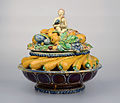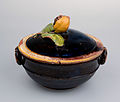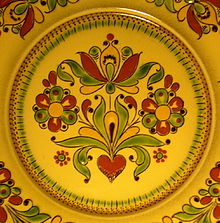Langnau ceramics
Lang pottery hot since the 17th century in Langnau im Emmental , Switzerland produced pottery . Langnau is the most important pottery location in the Canton of Bern when it comes to earthenware. In addition, in the 17th / 18th Century numerous pottery in the Heimberg region , in Bäriswil , Albligen and Blankenburg as well as in numerous other places in the Bernese landscape, z. B. in Langenthal . For many of these potteries no more comprehensive studies are available to date.
History of the pottery in Langnau
Ceramics have been produced in Langnau since the early 17th century. But it was only with the appearance of the Herrmann family, who had been active for several generations (first archival evidence 1674), that a center for the production of high-quality, excellently designed and outstandingly decorated with sayings and pictures was created. Between approx. 1670 and 1850 it is the most important and economically successful earthenware farm in the Bern region and, in addition to Winterthur, probably also in German-speaking Switzerland. Outside of Switzerland, there is no comparable high quality production in the German-speaking area during this period. It is no coincidence that a member of the Herrmann family was also director of the Frischingschen Fayencemanufaktur in Bern for a certain period of time . In this way, numerous vessel shapes and decorative elements from the Rococo came into production in Langnau. The preserved glaze recipe book by Daniel Herrmann, now in the Bernisches Historisches Museum , is an outstanding source of craft history.
The basis of the success was the economic upswing in the rural regions of the canton of Bern, which produced a proud, self-confident, educated and religiously motivated rural middle and upper class. The Langnau products, with their sayings and their images from the everyday life of farmers, craftsmen, soldiers and people of the Emmental, fit perfectly with their self-image. The decors and the pictures on the Langnau crockery are synonymous in their liveliness and their realism with the decors on contemporary furniture or on house facades. The fact that Langnau was the most important market place in the Emmental and the internationally known "Schärer" Michael Schüppach practiced here and offered his medical services to an international audience may also have contributed to the success .
For folklore, art history and archaeological cultural history research, the numerous dated Langnau ceramics provide a chronologically close-knit network for the analysis of craft, typological, stylistic and social developments as well as the differentiation of the various pottery regions in Switzerland.
Langnau "wedding bowl", terrine or show dinner, around 1800 from the Burgdorf Castle Museum
Langnau terrine with pomegranate handle, 1782 from the Burgdorf Castle Museum
"Im Gräbli", in Langnau Hinterdorfschachen, the Herrmann family's first pottery was built around 1672/1674. The information to be found in the literature that the family immigrated from the Black Forest has not yet been supported by archival documents. In the course of time, the Hermann family branched out, so that at times several potteries worked side by side. The oldest Langnau pottery ( Bernese German : Chacheli ) can be clearly assigned to the place of manufacture in Langnau from around 1715 on the basis of labeled pieces. The most beautiful works of the Langnau potters date from the period from 1720 to approx. 1850. Plant ornaments were first incised ( sgraffito technique) on a white background engobe and then painted with strong colors (red and green, later also yellow and blue) with the Malhorn . Around 1750, the flower motifs were accompanied by depictions of animals, people, castles, churches and scenes from everyday farming and craftsmanship. The finished products were sold from house to house over a wide area using so-called "tile carriers". The main sales area was presumably the Emmental, but there are also archaeological finds, e.g. B. from Bern, which prove that the urban population also appreciated Langnauer dishes in the 18th and 19th centuries.
After 1850 artistic and stylistic development ceased. The last potters Herrmann stopped their work in Langnau in 1904 and 1910 respectively. It was not until the late 19th century that successful efforts were made to revive the pottery and decorating traditions (Gerber / Stucki pottery in Langnau, Kohler pottery in Schüpbach, Aebi pottery in Trubschachen, Töpferhus Langnau). Even today there are some potteries in Langnau and the surrounding area that produce ceramics in the traditional Langnau style (= Alt-Langnau) (see picture).
Langnauer Hafner sayings
In addition to the beautiful pictures, numerous plates and bowls show incised sayings from the late 17th century onwards. These have an ethical-moral, religious, chronic or funny character. Examples are:
"We would go on and on, that every moment makes the service shorter."
"I would rather be single than give the woman the pants".
"If you fake it bad or good, you should thank Herregott."
«We shall let Mr. Zeitt fill with bathe and sing; The time is right, the dead come. "
"We learn all day and yet we don't learn too much, then bit that cool grave will host our house."
"The blessing of the Lord makes kingdom and brings no trouble with it, God alone the honor."
"I die and I don't know how or when - I don't know where - I am amazed that I at my end may be happy."
"Pierce thorns, burn Nesel, we want to know all whore boys."
"From the cradle bit into the grave, happiness and unhappiness grows."
Current research on Langnau ceramics
Despite the fact that the museum founders in Switzerland, Germany and England were already aware of the outstanding importance of Langnau in the late 19th century, a comprehensive monographic review of the pottery village of Langnau is still pending . The older literature is now largely inaccessible to the public and its content is partially outdated. The more recent publications on the subject devote an important chapter to Langnau, but due to their overriding objective they cannot replace the missing monographic template based on historical, museum and archaeological sources. This is where a project started that documented the entire inventory of all Langnau ceramics preserved in Switzerland from 2014 to 2017. All the information in this article is based on this new groundwork.
The importance and the handicraft value of the Langnau production is increasingly in danger of being forgotten, especially since large collections are no longer on display (Bern, Zurich, Basel, Bern School of Design). You can only get an impression of the beauty and quality of Langnau crockery today in the Musée Ariana in Geneva , in a special exhibition currently running at the Burgdorf Castle Museum , in the Kornhaus in Wiedlisbach and in the Chüechlihus Regional Museum in Langnau . The large collection there has meanwhile been comprehensively processed scientifically and in terms of cultural history.
All Langnau ceramics in public collections in Switzerland are now accessible online at ceramica-ch.ch.
Langnau ceramics in museums
The largest collection of Langnau tableware can be found in the Bern Historical Museum . The largest number of exhibited pieces can be seen in the Langnau local history museum Chüechlihuus. The most unusual pieces are kept in the Swiss National Museum in Zurich. Important collections of Langnau ceramics can also be found in the Musée Ariana in Geneva, the Castle Museum Burgdorf, the Castle Museum Thun and the Museum in the Kornhaus in Wiedlisbach . In Germany, Langnauer ceramics can be found in the Germanic National Museum in Nuremberg , in the Museum of Art and Crafts in Hamburg and in the Museum of Applied Arts in Berlin . In England, the Victoria and Albert Museum in London and the Fitzwilliam Museum in Cambridge keep Langnauer ceramics.
Literature on pottery in Langnau and the Herrmann pottery family
- Andreas Heege, Andreas Kistler, Poteries décorées de Suisse alémanique, 17e-19e siècles - Collections du Musée Ariana, Genève - Ceramics of German-speaking Switzerland, 17.-19. Century - The collection of the Musée Ariana, Geneva. Milan 2017.
- Emil Aeschlimann: Alt-Langnau pottery. A contribution to folklore. Bern 1928.
- Daniel Baud-Bovy: Peasant art in Switzerland. London 1924.
- Adriano Boschetti-Maradi: Pottery and Pottery in the Early Modern Age in the Canton of Bern (Writings of the Bernisches Historisches Museum 8). Bern 2006.
- Adriano Boschetti-Maradi: tableware for town and country. Bernese pottery since the 16th century (highlights from the Bernisches Historisches Museum 19). Bern 2007.
- René Creux: Folk Art in Switzerland. Paudex 1970.
- Max Fahrländer: Langnau pottery from Heimberg. In: Friends of Swiss Ceramics Bulletin 13, 1949, pp. 12-13.
- Andreas Heege, Andreas Kistler, Walter Thut: Ceramics from Bäriswil. On the history of an important farm in the canton of Bern. (= Writings of the Bernisches Historisches Museum. 10). Bern 2011.
- JOK: From the old Langnau dishes. In: The Bern Week in words and pictures. A sheet for local art and Art. No. 35, pp. 514–515.
- Valeria Legena: Bernese ceramics from the 17th to 19th centuries. In: Bern Foundation for Applied Art and Design (Ed.): Bern ceramics from past and present. Bern 1997, pp. 8-53.
- Bernard MA Rackham: Catalog of the Glaisher collection of pottery and porcelain in the Fitzwilliam Museum Cambridge. Cambridge 1935. (Reprinted 1987)
- Alfred Schneider: The potter Jakob Stucki. (= Searching and collecting. 4). Bern 1979.
- Rudolf Schnyder: Four Bernese ceramists. Werner Burri, Benno Geiger, Margrit Linck, Jakob Stucki. Bern 1985.
- Rudolf Schnyder: Bernese peasant ceramics. Text accompanying the exhibition of the same name by the Swiss National Museum at Wildegg Castle. In: Ceramic Friends of Switzerland. Bulletin 44, 1994, pp. 18-23.
- Rudolf Schnyder: Ceramics from Switzerland from Renaissance until the present. In: Cerâmica da Suìça do Renascimento aos nossos dias. Museu Nacional do Azulejo, Lisbon 1998, pp. 17-122.
- Walter A. Staehelin: Exhibition of Swiss ceramics of the 18th and 19th centuries. Jegenstorf Castle. Jegenstorf 1948.
- Walter A. Staehelin: A Langnauer wedding bowl from master Daniel Herrmann. In: Friends of Swiss ceramics. Bulletin 16, 1950, pp. 11-12.
- Jakob Wiedmer-Stern : Old Bernese peasant dishes. In: The Bund . 1907.
- Robert L. Wyss : Bernese peasant ceramics. (Berner Heimatbücher 100–103), Bern 1966.
- Robert L. Wyss: Bernese peasant pottery. In: Robert Wildhaber : Swiss folk art. Texts on the exhibition of “Pro Helvetia” and the “German Art Council” in 1967. Pro Helvetia, Zurich 1969, pp. 47–52.
- Robert L. Wyss: A Langnauer plate from the year 1733. In: Year book of Oberaargaus. 1980, pp. 25-31.
- Robert L. Wyss: Peasant Pottery. In: Peter Meyer (Ed.): Art and Culture in the Canton of Bern. (= Illustrated Bern Encyclopedia. 4). Bern 1987, pp. 110-114.
- Rudolf Zbinden, Max Pfister: Langnau iE - heart of the Upper Emmental. (= Bern homeland books. 89). Bern 1977, pp. 17-20.
Individual evidence
- ↑ See Adriano Boschetti-Maradi 2006.
- ↑ See Andreas Heege: Langenthal, St. Urbanstrasse 40-44. The Staub Hafnerei and its workshop. In: Archeology Bern. 2011, pp. 209-287.
- ↑ Wiedmer-Stern 1907; Baud-Bovy 1924; Aeschlimann 1928; JOK 1929; Rackham 1935; Staehelin 1948; Fahrländer 1949; Staehelin 1950; Wyss 1966; Wyss 1969; Creux 1970; Wyss 1980, Wyss 1987; Schnyder 1994; Lage 1997; Schnyder 1998, 37-38, 106-109
- ^ Boschetti-Maradi 2006 and Boschetti-Maradi 2007.
- ^ Andreas Heege / Andreas Kistler, ceramics from Langnau. On the history of the most important land havings in the canton of Bern (Writings of the Bernisches Historisches Museum 13), Bern 2017.
Web links
- Langnauer Keramik in CERAMICA CH - National Ceramic Inventory of Switzerland (1500-1950)
- The ultimate Langnau project!
- Do you fancy ceramics? Ceramic friends Switzerland!
- Homepage of the show pottery Kohler in Schüpbach (founded in 1869, oldest still working pottery in the Emmental)
- Possibility to search for ceramics from Langnau in the web-collection of the Swiss National Museum
- Search option in the catalog of the V&A Museum in London
- Regional Museum Langnau: Homepage of the most important museum for the pottery history of Langnau
- Museum in the Kornhaus Wiedlisbach: Bernese and Solothurn ceramics - Langnau, Heimberg, Bäriswil, Matzendorf
- Langnau, Bäriswil, Heimberg and much more ...
- ceramica-ch.ch


